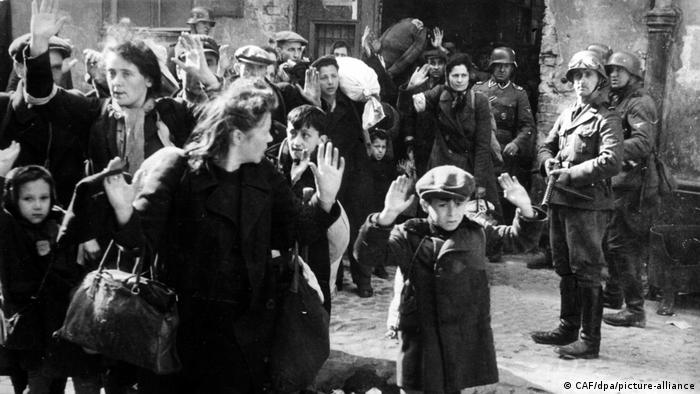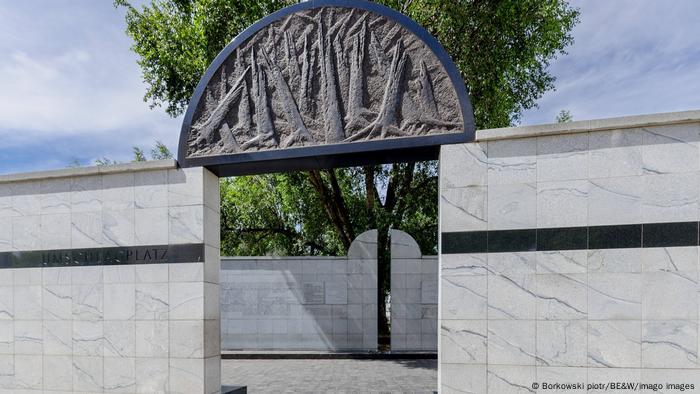In July 1942, the SS began exterminating the Jews of Warsaw. This will be commemorated with a memorial march in Poland this Friday.

Jews in the Warsaw ghetto wait with raised arms to be transported to Treblinka
The life of the Jews in the Polish capital of Warsaw 80 years ago was hell. Since the German invasion of Poland in September 1939, they have been subjected to constant persecution by the German occupiers. And since November 1940 they were cooped up in the Warsaw ghetto in the northwestern part of the city. Up to 450,000 men, women and children lived here in cramped quarters behind high walls. They were decimated by starvation, plague, and executions. Around 100,000 people lost their lives in this way.
Leaving the sealed-off area without permission was punishable by death, as was any outside help to the ghetto residents. The guards didn't even shy away from shooting at small children who were smuggling food or coal into the ghetto. Dead bodies on the side of the road, emaciated to the bone, were part of everyday life.
SS man Hermann Höfle gave the murder order
July 22, 1942 was to become a tragic turning point in the history of Warsaw's Jews, who before the war made up almost a third of the population of the Polish capital and had shaped the image of the city on the Vistula for many centuries.
< img src="https://static.dw.com/image/62525278_401.jpeg" />
Warsaw Jews arrive in the ghetto, from where they are deported to the extermination camps from July 1942
“At 10 a.m., Sturmbannfuhrer Höfle appeared with his companions,” Adam Czerniakow, the chairman of the Jewish Council set up by the Nazis, noted in his diary. “We were told that – with certain exceptions – the Jews without Gender and age difference are to be resettled in the East.” The Polish-Jewish engineer and politician Czerniakow was forcibly appointed by the occupiers to carry out their orders as head of the Judenrat: Every day he was to 6000 people ready for deportation from the ghetto. The SS soon increased the daily target to 10,000 people.
“They are asking me to kill the children of my people with my own hands,” Czerniakow wrote in a farewell letter to his wife on July 23, 1942, one day after the deportations began. “I have no choice but to die.” He ended his life with a cyanide capsule. But he could not stop the extermination action with his death.
The destination of the journey – the gas chamber of Treblinka
The deportation was carried out with the utmost brutality in order to nip any resistance in the bud. The individual houses were surrounded by the Jewish security service and the German units, their inhabitants herded into the yard with whips and sticks, formed in columns and taken to the so-called transshipment point at the train station.

The road to death: These railroad tracks led directly to the German Treblinka extermination camp
At the railway ramp there, the people were crammed into cattle cars and taken to the Treblinka extermination camp, where they usually died in the gas chambers on the same day after a drive of several hours. Later, when more people tried to hide, the starving people were lured into the trap with the promise of additional food allocations: if you volunteered, you got three kilos of bread and one kilo of jam per person.
The “Great Action” was disguised by the Germans as “resettlement to the east,” but soon many realized that death awaited them at the end of the journey. People who managed to escape from the trains warned their fellow citizens. Despite this, many – out of desperation or out of responsibility for their relatives – saw no way of escaping death.
Janusz Korczak dies with his children
At the beginning of August, the director of the orphanage, Janusz Korczak, appeared with his charges at the transshipment point. The respected doctor and educator had the opportunity to escape from the ghetto, but did not want to abandon the children in his care. To reassure them, he told them that they were “going to the country” and accompanied them to death.

Since 1911, Janusz Korczak headed the Jewish orphanage in Warsaw. He was murdered with his protégés in Treblinka
His colleague Stefania Wilczynska died with Korczak and the orphans. The pediatric nurse Adina Blady-Szwajgier chose a different path. She gave her young patients morphine and killed them before the Germans could get hold of them.
Within two months, according to German sources, more than 250,000 Jews were deported to Treblinka. Jewish sources speak of almost 300,000 victims. Several thousand sick and old people who were unable to travel were shot in the Jewish cemetery in Warsaw.

“Taken out of the bunkers by force” was the original inscription under the picture from the Warsaw Ghetto, probably from May 1943
Approximately 35,000 Jews who were employed as workers in factories survived. 20,000 to 25,000 people escaped deportation and continued to live illegally in the remaining ghetto. When they were about to be deported from there in April 1943, the Warsaw Ghetto Uprising began. 13,000 Jews were killed. The rest were taken to Treblinka and other camps. “Jewish Warsaw has ceased to exist,” said an eyewitness note. The largest Jewish community in Europe was annihilated.
Globocnik's diabolical plan
The murder of the Warsaw Jews was only part of an overall plan for the annihilation of all Jews in German-occupied Poland, known by the code name “Action Reinhardt”.
As early as October 13, 1941, Heinrich Himmler had instructed the SS and police leader in the Lublin district, Odilo Globocnik, to murder the Jews in his sphere of influence in the south of the occupied country. He immediately began building the first death camp – Belzec. Later, two more camps of this type were set up, in which the victims were gassed immediately upon arrival – Sobibor and Treblinka. From 1943, Majdanek near Lublin also served as an extermination site.

Globocnik recruited men with experience from the so-called euthanasia program for his criminal project. By August 1941, around 70,000 patients from psychiatric hospitals had been killed in Germany as part of the so-called “Action-T4”, mostly with gas. Christian Wirth, appointed chief of all camps of Aktion Reinhardt, had previously been inspector of all institutions of the euthanasia program.
On the night of March 16-17, 1942, the extermination of the Jews in Lublin began. Step by step the murder was extended to the whole area of occupied Poland. The killing lasted until November 1943, when the camps were closed and the last prisoners were shot. The Holocaust researcher Stephan Lehnstaedt estimates the total number of victims of the Reinhardt operation at at least 1.8 million, maybe even two million. In his book “The Core of the Holocaust”, the historian speaks of the “most important crime complex of the Holocaust”.
The extermination of the European Jews continued afterwards. A total of six million Jews were murdered, and hundreds of thousands of Sinti and Roma fell victim to the genocide.
Hardly any survivors, forgotten places
Only about 150 people survived Belzec, Sobibor and Treblinka. The former German extermination camps were almost forgotten for a long time. The Auschwitz camp became a symbol of the Holocaust. The memorial sites of Aktion Reinhardt are only slowly returning to social awareness.

The transshipment point at the Warsaw ghetto is now a memorial
The memorial march in Warsaw contributes to the renewal of the memory of this terrible chapter in history. The ghetto area in Warsaw was razed to the ground by the Germans. After the war, a new housing estate was built there. There are hardly any traces of the Jewish population left in Poland's capital. It was not until 1988 that a memorial was erected at the former transshipment point, where the Warsaw Jews were gathered for deportation.
The participants in the memorial march on the 80th anniversary of the beginning of Operation Reinhardt will be on Friday (22.07. 2022) from this point walk to Nalewki Street, a small alley that was once in the center of the Jewish Quarter. Here only the cobblestones and the no longer used tram tracks come from the time of the ghetto and the deportation.

